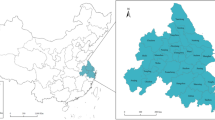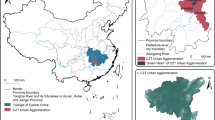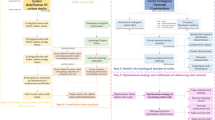Abstract
Analysis of the structure and function of urban energy metabolic systems is an important tool to facilitate compliance with China’s current energy-conservation policy. In this study, we used network throughflow analysis and network utility analysis to analyze the structure of an urban energy metabolic system and the complex relationships among its components. Using weight distributions in the network flow matrix, we determined the system structure; using the sign distribution in the network utility matrix, we determined the relationships between pairs of components. We then developed an ecological network model using Beijing in 1995, 2000, 2005, and 2007 as an example of how the model can be used to understand the system’s structure and function. The model’s components were the energy exploitation, transformation, consumption, and recovery sectors. Network throughflow analysis revealed that the energy transformation and consumption sectors had high weights (34–45%) in all 4 years, whereas the energy recovery sector had small weights (<5%) and the energy exploitation had low to intermediate weights (which decreased from 23% in 1995 to 11% in 2007). Network utility analysis revealed that the ecological relationships between the energy transformation and exploitation sectors, the energy consumption and transformation sectors, and the energy consumption and exploitation sectors did not change, but that the ecological relationships between the energy recovery sector and other sectors changed greatly. Our analysis of Beijing’s urban energy metabolic system provided guidance for optimizing the system’s structure and adjusting the relationships among the sectors.


Similar content being viewed by others
References
Aguayo F, Gallagher KP (2005) Economic reform, energy, and development: the case of Mexican manufacturing. Energ Policy 33(7):829–837
Alcantara V, Duarte R (2004) Comparison of energy intensities in European Union countries. Results of a structural decomposition analysis. Energ Policy 32(2):177–189
Andras P, Gwyther R, Madalinski AA, Lynden SJ, Andras A, Young MP (2007) Ecological network analysis: an application to the evaluation of effects of pesticide use in an agricultural environment. Pest Manag Sci 63(10):943–953
Bailey R, Bras B, Allen JK (2004a) Applying ecological input-output flow analysis to material flows in industrial systems. Part I. Tracing flows. J Ind Ecol 8(1–2):45–68
Bailey R, Bras B, Allen JK (2004b) Applying ecological input-output flow analysis to material flows in industrial systems. Part II. Flow metrics. J Ind Ecol 8(1–2):69–91
Bailey R, Bras B, Allen JK (2008) Measuring material cycling in industrial systems. Resour Conserv Recy 52(4):643–652
Baird D, Fath BD, Ulanowicz RE, Asmus H, Asmus R (2009) On the consequences of aggregation and balancing of networks on system properties derived from ecological network analysis. Ecol Model 220(23):3465–3471
Batabyal AA (2001) A theoretical inquiry into aspects of the structure and the management of ecological-economics systems. Stoch Environ Res Risk Assess 15:173–184
Browne D, O’Regan B, Moles R (2010) Use of multi-criteria decision analysis to explore alternative domestic energy and electricity policy scenarios in an Irish city-region. Energy 35(2):518–528
Burns TP (1989) Lindeman’s contradiction and the trophic structure of ecosystems. Ecology 70(5):1355–1362
Burns TP, Higashi M, Wainright SC, Patten BC (1991) Trophic unfolding of a continental shelf energy-flow network. Ecol Model 55(1–2):1–26
Chen DJ (2003) Analysis, integration and complexity study of industrial ecosystems. Dissertation, Tsinghua University (in Chinese)
Christian RR, Brinson MM, Dame JK, Johnson G, Peterson CH, Baird D (2009) Ecological network analyses and their use for establishing reference domain in functional assessment of an estuary. Ecol Model 220(22):3113–3122
Fath BD (2007) Network mutualism: Positive community-level relations in ecosystems. Ecol Model 208(1):56–67
Fath BD, Borrett SR (2006) A MATLAB function for Network Environ Analysis. Environ Modell Softw 21(3):375–405
Fath BD, Patten BC (1999a) Quantifying resource homogenization using network flow analysis. Ecol Model 123(2–3):193–205
Fath BD, Patten BC (1999b) Review of the foundations of network environ analysis. Ecosystems 2(2):167–179
Fath BD, Scharler UM, Ulanowicz RE, Hannon B (2004) Ecological network analysis: network construction. Ecol Model 208(1):49–55
Feng TW, Sun LY, Zhang Y (2009) The relationship between energy consumption structure, economic structure and energy intensity in China. Energ Policy 37(12):5475–5483
Finn JT (1976) Measures of ecosystem structure and function derived from analysis of flows. J Theor Biol 56(2):363–380
Finn JT (1980) Flow analysis of models of the hubbard brook ecosystem. Ecology 61(3):562–571
Han ZY, Fan Y, Jiao JL, Yan JS, Wei YM (2007) Energy structure, marginal efficiency and substitution rate: An empirical study of China. Energy 32(6):935–942
Hannon B (1973) The structure of ecosystems. J Theor Biol 41(3):535–546
Haralambopoulos DA, Fappas P, Safos M, Kovras H (2001) The structure of residential energy use on a North Aegean island: the town of Mytilene. Energy 26(2):187–196
Heymans JJ, Ulanowicz RE, Bondavalli C (2002) Network analysis of the South Florida Everglades graminoid marshes and comparison with nearby cypress ecosystems. Ecol Model 149(1–2):5–23
Huang GH, Chang NB (2003) Persperctives of environmental informatics and systems analysis. J Environ Inform 1(1):1–6
Jovanovic M, Afgan N, Radovanovic P, Atevanovic V (2009) Sustainable development of the Belgrade energy system. Energy 34(5):532–539
Kilic FC, Kaya D (2007) Energy production, consumption, policies, and recent developments in Turkey. Renew Sust Energ Rev 11(6):1312–1320
Leontief WW (1966) Input-output economics. Oxford University Press, New York
Li Y, Chen B, Yang ZF (2009) Ecological network analysis for water use systems—a case study of the Yellow River Basin. Ecol Model 220(22):3163–3173
Mendiluce M, Perez-Arriaga I, Ocana C (2010) Comparison of the evolution of energy intensity in Spain and in the EU15. Why is Spain different? Energ Policy 38(1):639–645
Morris SCI, Goldstein GA, Sanghi A, Hill D (1996) Energy demand and supply in Metropolitan New York with global climate change. Ann N Y Acad Sci 790:139–150
National Bureau of Statistics of China (1998, 2004, 2007, 2008) China Energy Statistical Yearbook (1991-1996, 2000-2002, 2006, 2008). China Statistics Press, Beijing (in Chinese)
Patten BC (1978) Systems approach to the concept of environment. Ohio J Sci 78(4):206–222
Patten BC, Bosserman RW, Finn JT, Cale WG (1976) Propagation of cause in ecosystems. In: Patten BC (ed) Systems analysis and simulation in ecology, vol IV. Academic Press, New York, pp 457–579
Sørensen B (2008) A sustainable energy future: construction of demand and renewable energy supply scenarios. Int J of Energ Res 32(5):436–470
Uchiyama Y (2002) Present efforts of saving energy and future energy demand/supply in Japan. Energ Convers and Manage 43(9–12):1123–1131
Yang ZF, Zhao W (2008) Analysis on evolution of urban energy system structure based on information entropy. Energ Source Part A 30(14–15):1400–1412
Zhang Y, Yang ZF, Yu XY (2009) Ecological network and emergy analysis of urban metabolic systems: Model development, and a case study of four Chinese cities. Ecol Model 220(11):1431–1442
Zhang Y, Yang ZF, Fath BD, Li SS (2010) Ecological network analysis of an urban energy metabolic system: Model development, and a case study of four Chinese cities. Ecol Model 221(16):1865–1879
Zhao W (2006) Energy structure analysis, optimization and regulation in an urban ecological economic system. Dissertation, Beijing Normal University (in Chinese)
Acknowledgments
This work was supported by the National Natural Science Foundation of China (Nos. 40701004 and 40871056), the Program for Changjiang Scholars and Innovative Research Team in University (No. IRT0809), and the Fundamental Research Funds for the Central Universities.
Author information
Authors and Affiliations
Corresponding author
Electronic supplementary material
Rights and permissions
About this article
Cite this article
Zhang, J., Zhang, Y. & Yang, Z. Ecological network analysis of an urban energy metabolic system. Stoch Environ Res Risk Assess 25, 685–695 (2011). https://doi.org/10.1007/s00477-011-0474-8
Published:
Issue Date:
DOI: https://doi.org/10.1007/s00477-011-0474-8




